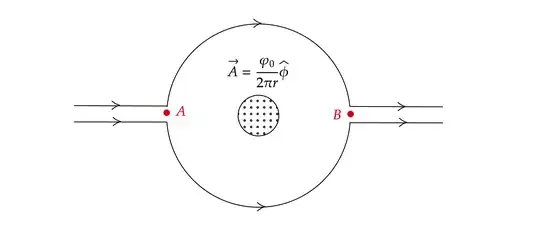Under a local gauge (phase?) transformation of the field operator for electrically charged fields, $\psi \rightarrow e^{\mathrm{i}\phi(x_{\mu})}\psi$, where $e^{\mathrm{i}\phi(x_{\mu})} \in U(1)$, the associated $\mathcal{L}$ remains invariant if we add an electromagnetic potential $A_{\mu}$ to it.
(If instead of performing a local gauge transformation we perform a global one, $\psi \rightarrow e^{\mathrm{i}\phi}\psi$, then no four-potential $A_{\mu}$ has to be added to the Lagrangian to keep it invariant under this transformation. This transformation is, via Noether's theorem, associated with the conservation of the number of particles (or "conservation of probability") and thus electric charge).
All neat and well. Now, look at the shifted pattern of the double-slit experiment. Can we reason in the other direction too? Can we say that if we physically make a four potential $A_{\mu}$ appear (in this case only the space part is present) appear, as in the experiment, that this causes the shift in the diffraction pattern? Does this field, which is constant, induce, indirectly, a global transformation on the pattern? Or, directly, a local gauge transformation on the electron field (states)? It looks as if the pattern is globally phase transformed. This means that the electron-field "in-between" is globally transformed too. Is the four-potential inducing phase-shifts on the electron field between slits and screen? Thereby making some paths more and some paths less probable (in the path integral formulation)? Note that the diffraction pattern moves in the other direction if the current inside the solenoid is reversed.
So it seems as if the global phase transformed pattern stands in direct relation to locally transformed electron states. Can we say these states are not gauge transformed at random (as in the mathematical procedure of imposing a local gauge transformation on the charged field which makes an $A$-field show up) but as a result of the $A$-field (which is cylindrical symmetric and constant in time)?
Or stated in still another way: can we say that instead of the fact that a local gauge transformation gives rise to an $A_{\mu}$ field the reverse holds, namely that an applied $A_{\mu}$ field gives rise to real local phase transformations? Moreover, in the face of quantum fields mapping spacetime points to operators, this doesn't seem unreasonable.
I found some new information on this subject:
4.3 The Aharonov-Bohm effect The Aharonov-Bohm effect (Aharonov and Bohm, 1959) deserves special attention since it is often considered to be an instance of the Berry phase. The scenario is very well known: a split electron beam passes around a solenoid in which a magnetic field is confined. The region outside the solenoid is field-free, but nevertheless, a shift in the interference pattern on a screen behind the solenoid can be observed upon alteration of the magnetic field. The phase shift can be calculated from the loop integral over the potential, which—due to Stokes’ theorem—relates to the magnetic flux,...etc.
More can be read here, where the Berry phase is discussed. Somehow this seemed important for this problem. I don't know exactly how though.

